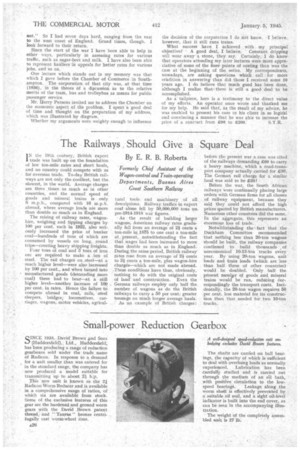The Railways Should Give a Square Deal
Page 28

If you've noticed an error in this article please click here to report it so we can fix it.
By E. R. B. Roberts
Formerly Chief Assistant of the Wagon-control and Train-operating Departments, Buenos Aires Great Southern Railway
1N the 10th century, British export 1 trade was built up on the foundation of low ton-mile rates and short hauls, and no country could compete with us for overseas trade. To-day British railways are not only the costliest, but the slowest, in the world. Average charges are three times as much as in other countries, and the normal speed of goods and mineral trains is only 8 m.p.h., compared with 16 m.p.h. abroad, where average loads ale more than double as much as in England.
The raising of railway rates, wagonhire, weighing and tipping charges by 100 per cent, each in 1922, also seriously increased the price of bunker coal—hundreds of tons of which are consumed by vessels on long, round trips—creating heavy shipping freights_ Four tons of coal and 3 tons of iron ore are required to make a ton of steel. The rail charge § on steel—at a much higher level—were also increased by 100 per cent., and when turned into manufactured goods (demanding more coal) these had to bear—at a still higher level—another increase of iog per cent. in rates. Hence the failure to compete abroad in coal, rails, ,steel sleepers, bridges; locomotives, carriages, wagons, motor vehicles, agricul
tural. tools and machinery of all descriptions. Railway traffics in export coal alone fell by 50,000,000 tons onpre-1914-1918 war figures.
As the result of building larger wagons-, American railway rates gradually fell from an average of a cents a ton-mile in .1875 to one cent a ton-mile at _ present, notwithstanding the fact that wages had been increased to more than double as much as in England.
• During the same period, British railway rates rose from an average of 2i cents to 3i cents a ton-mile, plus wagon-hire charges—which arc not made abroad. These conditions have thus, obviously, nothing to do with the original costs of land' and construCtion. Even the German railways employ only half the number of wagons as do the British railways to early a 30 per cent: greater tonnage on much longer average hauls.
• As an example of British charges: before the present war a case was cited of the railways demanding 460 to carry a heavy machine, which a road-transport company actually carried for £30. The German rail charge for a similar haul was said to be £20 I Before the war, the South African railways were continually placing large orders with German firms for all classes of railway equipment, because they said they could not afford the high prices quoted by British manufacturers. Numerous other countries did the same. In the aggregate, this represents an enormous loss of trade.
Notwithstanding the fact that the Duckharn Committee recommended that nothing less than 20-ton wagons -should be built, the railway companies continued to build thousands of uneconomical 10-13-ton 'trucks every year. By using 20-ton wagons, unit loads and train loads (which are less than half those of other countries) would be doubled. Only half the present nundapr of goods and mineral trains would be run, reducing Correspondingly the transport costs. Incidentally, the 20-ton wagon requires 50 per cent. less material for its construction than that needed for two 10-ton trucks.




















































